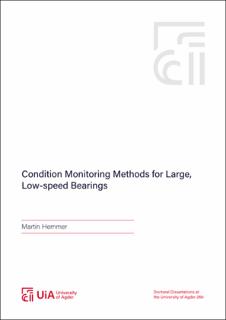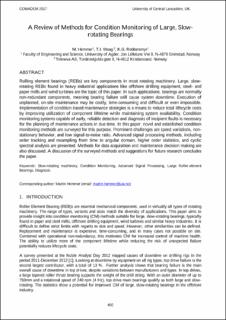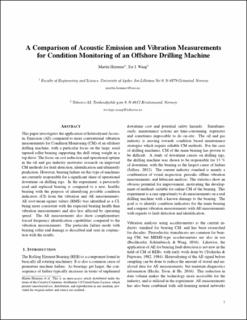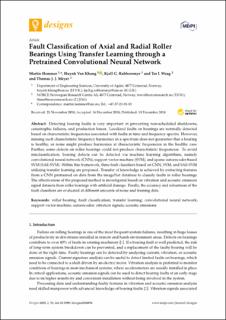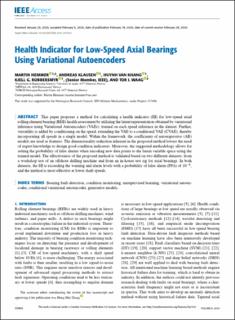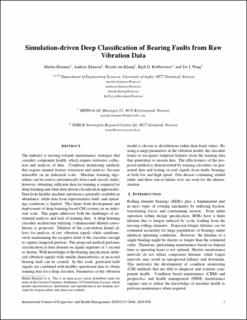| dc.contributor.author | Hemmer, Martin | |
| dc.date.accessioned | 2020-05-11T10:56:23Z | |
| dc.date.available | 2020-05-11T10:56:23Z | |
| dc.date.created | 2020-04-29T11:45:50Z | |
| dc.date.issued | 2020 | |
| dc.identifier.citation | Hemmer, M. (2020). Condition Monitoring Methods for Large, Low-speed Bearings (Doctoral thesis). University of Agder, Oslo. | en_US |
| dc.identifier.isbn | 978-82-7117-960-1 | |
| dc.identifier.issn | 1504-9272 | |
| dc.identifier.uri | https://hdl.handle.net/11250/2653864 | |
| dc.description.abstract | In all industrial production plants, well-functioning machines and systems are required for sustained and safe operation. However, asset performance degrades over time and may lead to reduced effiency, poor product quality, secondary damage to other assets or even complete failure and unplanned downtime of critical systems. Besides the potential safety hazards from machine failure, the economic consequences are large, particularly in offshore applications where repairs are difficult. This thesis focuses on large, low-speed rolling element bearings, concretized by the main swivel bearing of an offshore drilling machine. Surveys have shown that bearing failure in drilling machines is a major cause of rig downtime. Bearings have a finite lifetime, which can be estimated using formulas supplied by the bearing manufacturer. Premature failure may still occur as a result of irregularities in operating conditions and use, lubrication, mounting, contamination, or external environmental factors. On the contrary, a bearing may also exceed the expected lifetime. Compared to smaller bearings, historical failure data from large, low-speed machinery is rare. Due to the high cost of maintenance and repairs, the preferred maintenance arrangement is often condition based. Vibration measurements with accelerometers is the most common data acquisition technique. However, vibration based condition monitoring of large, low-speed bearings is challenging, due to non-stationary operating conditions, low kinetic energy and increased distance from fault to transducer. On the sensor side, this project has also investigated the usage of acoustic emission sensors for condition monitoring purposes.
Roller end damage is identified as a failure mode of interest in tapered axial bearings. Early stage abrasive wear has been observed on bearings in drilling machines. The failure mode is currently only detectable upon visual inspection and potentially through wear debris in the bearing lubricant. In this thesis, multiple machine learning algorithms are developed and applied to handle the challenges of fault detection in large, low-speed bearings with little or no historical data and unknown fault signatures. The feasibility of transfer learning is demonstrated, as an approach to speed up implementation of automated fault detection systems when historical failure data is available. Variational autoencoders are proposed as a method for unsupervised dimensionality reduction and feature extraction, being useful for obtaining a health indicator with a statistical anomaly detection threshold. Data is collected from numerous experiments throughout the project. Most notably, a test was performed on a real offshore drilling machine with roller end wear in the bearing. To replicate this failure mode and aid development of condition monitoring methods, an axial bearing test rig has been designed and built as a part of the project. An overview of all experiments, methods and results are given in the thesis, with details covered in the appended papers. | en_US |
| dc.language.iso | eng | en_US |
| dc.publisher | Media 07 | en_US |
| dc.relation.ispartofseries | Doctoral Dissertations at the University of Agder; no. 260 | |
| dc.relation.haspart | Hemmer, M., Waag, T. I. & Robbersmyr, K. G. (2017). A Review of Methods for Condition Monitoring of Large, Slow-rotating Bearings. In I. Sherrington, A. Onsy, R. Rao, H. L. Brooks & J. Philip (Eds.), 30th International Conference on Condition Monitoring and Diagnostic Engineering Management (p . 450-458). Preston, UK: University of Central Lancashire. http://clok.uclan.ac.uk/24444/. Distributed under the terms of the Creative Commons Attribution-NonCommercial-NoDerivatives 4.0 License. | en_US |
| dc.relation.haspart | Hemmer, M. & Waag, T. I. (2017). A Comparison of Acoustic Emission and Vibration Measurements for Condition Monitoring of an Offshore Drilling Machine. Proceedings of the Annual Conference of the Prognostics and Health Management Society, 8: 031. http://www.phmsociety.org/node/2345/. | en_US |
| dc.relation.haspart | Hemmer, M., Robbersmyr, K. G., Waag, T. I., Meyer, T. J. J., Albrigtsen, R., Pedersen, T. & Vercammen, C. (2020). Rib-Roller Wear in Tapered Rolling Element Bearings: Analysis and Development of Test Rig for Condition Monitoring. In J. P. Liyanage, J. Amadi-Echendu &
J. Mathew (Eds.), Engineering Assets and Public Infrastructures in the Age of Digitalization. Cham: Springer International Publishing. doi: https://doi.org/10.1007/978-3-030-48021-9. Author-submitted manuscript. © 2020 Springer Nature Switzerland AG. | |
| dc.relation.haspart | Hemmer, M., Huynh, K., Robbersmyr, K. G., Waag, T. I. & Meyer, T. (2018). Fault Classification of Axial and Radial Roller Bearings Using Transfer Learning through a Pretrained Convolutional Neural Network. Designs, 2(4): 56. doi: https://doi.org/10.3390/designs2040056. | |
| dc.relation.haspart | Hemmer, M., Klausen, A., Huynh, K., Robbersmyr, K. G. & Waag, T. I. (2020). Health Indicator for Low-speed Axial Bearings using Variational Autoencoders. IEEE Access, 8, 35842-35852. doi: https://doi.org/10.1109/ACCESS.2020.2974942. | |
| dc.relation.haspart | Hemmer, M., Klausen, A., Huynh, K., Robbersmyr, K. G. & Waag, T. I. (2019). Simulation-driven Deep Classification of Bearing Faults from Raw Vibration Data. International Journal of Prognostics and Health Management, 10(Special Issue on Deep Learning and Emerging Analytics): 030. http://www.phmsociety.org/references/ijphm-archives/2019/Sp11. Full-text is available in AURA as a separate file: https://hdl.handle.net/11250/2648526. | |
| dc.title | Condition Monitoring Methods for Large, Low-speed Bearings | en_US |
| dc.type | Doctoral thesis | en_US |
| dc.description.version | publishedVersion | en_US |
| dc.rights.holder | © 2020 Martin Hemmer | en_US |
| dc.subject.nsi | VDP::Teknologi: 500::Maskinfag: 570 | en_US |
| dc.source.pagenumber | 222 | en_US |
| dc.source.issue | 260 | en_US |
| dc.identifier.cristin | 1808608 | |
| dc.relation.project | Norges forskningsråd: 237896 | en_US |
